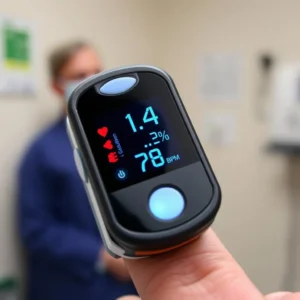Is a Perfusion Index of 1.4 Acceptable? What the Numbers Mean
When it comes to monitoring health, especially in critical situations, understanding the numbers on medical devices is crucial. One such number is the perfusion index (PI), a value that often raises questions like, “Is a perfusion index of 1.4 good?” In this comprehensive guide, we’ll dive deep into what the perfusion index means, its significance, and whether a PI of 1.4 is acceptable.
What Is the Perfusion Index?
The perfusion index (PI) is a measurement that indicates the strength of blood flow to peripheral tissues, such as your fingers or toes. It’s often displayed on pulse oximeters, devices used to measure oxygen saturation (SpO2) and heart rate. The PI is expressed as a percentage, with values typically ranging from 0.02% to 20%.
Key Points About Perfusion Index:
- Low PI (0.02% – 0.5%): Indicates weak blood flow, often due to cold extremities, poor circulation, or shock.
- Normal PI (0.5% – 5%): Represents healthy blood flow in most individuals.
- High PI (Above 5%): Suggests strong blood flow, which is generally a positive sign but can sometimes indicate hyperdynamic circulation.
So, where does a perfusion index of 1.4 fall? Let’s explore this in detail.
Is a Perfusion Index of 1.4 Good?
A perfusion index of 1.4 falls within the normal range (0.5% – 5%), indicating adequate blood flow to the peripheral tissues. However, whether it’s “good” depends on the context:
Factors to Consider:
- Baseline PI: Everyone has a unique baseline PI. For some, 1.4 might be slightly low, while for others, it’s perfectly normal.
- Health Conditions: Conditions like hypothermia, Raynaud’s disease, or cardiovascular issues can affect PI.
- Environmental Factors: Cold temperatures or stress can temporarily lower PI.
When to Be Concerned:
- If your PI drops below 0.5%, it may indicate poor circulation or a medical emergency.
- Consistently low PI values warrant a consultation with a healthcare professional.
For most people, a PI of 1.4 is acceptable, but it’s essential to monitor trends over time rather than focusing on a single reading.
How Is the Perfusion Index Measured?
The perfusion index is measured using a pulse oximeter, a non-invasive device that clips onto your finger, toe, or earlobe. It uses infrared light to assess blood flow and oxygen levels.
Steps to Measure PI:
- Place the pulse oximeter on your finger.
- Wait a few seconds for the device to display your SpO2, heart rate, and PI.
- Record the PI value and compare it to your baseline or normal range.
For accurate readings, ensure your hands are warm, and the device is properly positioned.
What Affects the Perfusion Index?
Several factors can influence your PI, including:
1. Temperature
Cold environments can constrict blood vessels, reducing blood flow to the extremities and lowering PI.
2. Physical Activity
Exercise increases blood flow, which can temporarily raise your PI.
3. Medical Conditions
- Hypovolemia: Low blood volume can decrease PI.
- Peripheral Artery Disease (PAD): Narrowed arteries reduce blood flow.
- Shock: A life-threatening condition that severely impacts circulation.
4. Medications
Certain drugs, like vasoconstrictors, can lower PI by narrowing blood vessels.
Why Is the Perfusion Index Important?
The perfusion index is more than just a number—it’s a valuable tool for assessing:
1. Circulatory Health
A consistently low PI may indicate poor circulation, prompting further investigation.
2. Anesthesia Monitoring
During surgery, PI helps anesthesiologists monitor blood flow and ensure patient safety.
3. Neonatal Care
In newborns, PI is used to assess peripheral perfusion and detect conditions like sepsis.
4. Emergency Situations
In emergencies, a low PI can signal shock or other critical conditions requiring immediate intervention.
How to Improve Your Perfusion Index
If your PI is consistently low, here are some actionable tips to improve it:
1. Stay Warm
- Wear gloves and socks in cold weather.
- Use hand warmers if necessary.
2. Exercise Regularly
Physical activity improves circulation and can raise your PI.
3. Stay Hydrated
Dehydration can reduce blood volume, lowering PI. Drink plenty of water throughout the day.
4. Manage Stress
Stress can constrict blood vessels. Practice relaxation techniques like deep breathing or meditation.
5. Consult a Doctor
If lifestyle changes don’t improve your PI, seek medical advice to rule out underlying conditions.
Common Questions About Perfusion Index
1. What Is a Normal PI Range?
A normal PI ranges from 0.5% to 5%. Values outside this range may require further evaluation.
2. Can PI Be Too High?
While a high PI is generally a sign of good circulation, extremely high values may indicate hyperdynamic circulation, often seen in conditions like sepsis.
3. Does Age Affect PI?
Yes, PI tends to decrease with age due to reduced peripheral circulation.
4. Can PI Predict Health Issues?
While PI alone isn’t diagnostic, it can provide valuable insights when combined with other metrics like SpO2 and heart rate.
Conclusion
So, is a perfusion index of 1.4 good? For most people, yes—it falls within the normal range and indicates adequate blood flow. However, it’s essential to consider individual factors like baseline PI, health conditions, and environmental influences.
If you’re concerned about your perfusion index or have questions about your readings, don’t hesitate to reach out to a healthcare professional. For more information or personalized assistance, visit our contact page or connect with us on WhatsApp.

